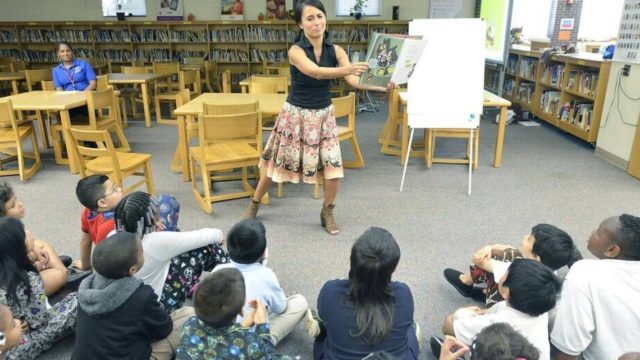
Author LeUyen Pham reads one of her books to second graders at Westerly Hills Elementary in Charlotte. John D. Simmons Observer file photo
State Superintendent Mark Johnson announced a $4.8 million plan to buy books, digital subscriptions and other reading aids for 479,000 K-3 students across North Carolina.
The allotment comes to $200 per teacher in those grades and will be distributed this month to school districts and charter schools. It’s part of North Carolina’s Read to Achieve program, a long-running quest to improve reading that has so far fallen short.
“Early-grade teachers are working extremely hard to get students reading on track by the end of third grade, and we are very pleased to be able to support them with these resources,” Johnson said Thursday. “Rather than make the decisions for them in Raleigh, we want districts and principals to partner with their K-3 reading teachers to decide what materials they need for their students and classrooms.”
It was unclear Thursday when the materials would reach classrooms and who would make the selection – for instance, whether district leaders would make a bulk purchase or whether individual schools and teachers could choose what they want. The money can be spent on books for classrooms or to send home with students, digital subscriptions or other literacy aids.
The Read to Achieve program is part of the state’s 2012 Excellent Public Schools Act, which took effect in 2013. It is best known for restricting the ability of children who fail the third-grade reading exam to be promoted.
Despite intensive testing, new instructional techniques and volunteer recruitment, all designed to help the youngest readers, proficiency has remained flat. Last year just under 58 percent of all third-graders earned a grade-level score, with pass rates well below 50 percent for black, Hispanic and low-income children.
Only 44 percent of all third-graders – and only about 30 percent of black, Hispanic and low-income students – earned the slightly higher reading score that indicates they’re on track for college and career readiness.
Third-grade reading ability is considered a benchmark for the odds of academic achievement in later grades.
“Preparing our youngest students to read successfully in school will prepare them for success in life,” Johnson said.
Written by Ann Doss Helms and published by The Charlotte Observer ~ March 08, 2018.
 FAIR USE NOTICE: This site contains copyrighted material the use of which has not always been specifically authorized by the copyright owner. We are making such material available in our efforts to advance understanding of environmental, political, human rights, economic, democracy, scientific, and social justice issues, etc. We believe this constitutes a ‘fair use’ of any such copyrighted material as provided for in section 107 of the US Copyright Law. In accordance with Title 17 U. S. C. Section 107, the material on this site is distributed without profit to those who have expressed a prior interest in receiving the included information for research and educational purposes. For more information go to: http://www.law.cornell.edu/uscode/17/107.shtml
FAIR USE NOTICE: This site contains copyrighted material the use of which has not always been specifically authorized by the copyright owner. We are making such material available in our efforts to advance understanding of environmental, political, human rights, economic, democracy, scientific, and social justice issues, etc. We believe this constitutes a ‘fair use’ of any such copyrighted material as provided for in section 107 of the US Copyright Law. In accordance with Title 17 U. S. C. Section 107, the material on this site is distributed without profit to those who have expressed a prior interest in receiving the included information for research and educational purposes. For more information go to: http://www.law.cornell.edu/uscode/17/107.shtml

The problem with kids reading is multi-pronged issue. First you have multiple reading programs that are Internet based, that have books that are inappropriately leveled for the reading age. Second are kids nowadays have all different ways to get online. They spend inordinate amounts of time on social media, watching videos or playing games. Third, how many homes nowadays have even one book or parents that push reading. Multiple problems listed above that all combined make for a distracted child or even adult.